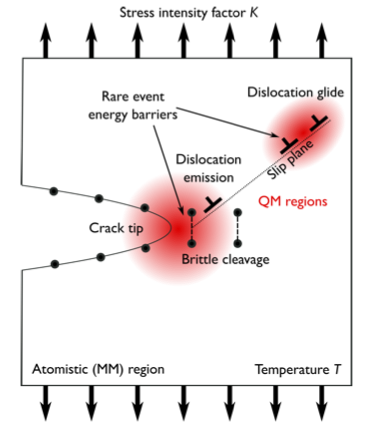Atomistically Informed Fatigue Crack Growth Models
Supervisors: James Kermode (Engineering) and Tyler London (TWI Global, Cambridge)
The demanding conditions experienced by welded structures create significant challenges for design and assessment. Due to their reliance on empirical criteria, existing fracture mechanics assessment codes and standards may lead to either over-conservative assessments or the crack tip conditions may be underestimated depending on the nature of the case analysed. The emphasis in this project will be on obtaining more accurate fracture mechanics analyses of fatigue processes through the direct modelling of crack propagation at the atomic scale.
Accurate atomistic modelling of “chemomechanical” processes that involve breaking of chemical bonds driven by long range stress requires a multiscale approach such as the ‘Learn on the Fly’ (LOTF) scheme [1]. The applicability of this approach has recently been extended to rare events [2] and to metallic systems [3], bringing processes relevant to fracture and fatigue in metals in reach for the first time. In this project atomistic models of this kind will be used to inform improved continuum descriptions based on the Paris law [4] as a function of chemical environment (e.g. H concentration) and other micromechanical mechanisms.

Atomistic modelling of crack growth processes including cleavage, dislocation emission and dislocation glide. Regions where chemical bond-breaking takes place (coloured red) will be modelled with quantum mechanical precision.
References
[1] J. R. Kermode, T. Albaret, D. Sherman, N. Bernstein, P. Gumbsch, M. C. Payne, G. Csányi, and A. De Vita, Nature 455, 1224 (2008).
[2] J. R. Kermode, A. Gleizer, G. Kovel, L. Pastewka, G. Csányi, D. Sherman, and A. De Vita, Phys. Rev. Lett. 115, 135501 (2015).
[3] F. Bianchini, J. R. Kermode, and A. De Vita, Modell. Simul. Mater. Sci. Eng. 24, 045012 (2016).
[4] T. London, S. D. Smith, and Ş. E. Eren, in ASME 2014 Pressure Vessels and Piping Conference (American Society of Mechanical Engineers, 2014)
